Introduction
In the development of the digital asset market in recent years, the roles of Centralized Exchanges (CEX) and Decentralized Exchanges (DEX) have gradually become the core topics of interest for investors and researchers. Although the market has a certain understanding of these two trading models, their impacts and differences in various application scenarios are still worth exploring in depth.
In the past two years, the usage rate of DEX has significantly increased globally, with more and more investors beginning to accumulate experience and reflections through on-chain trading and wallet management, indicating that decentralized trading is rapidly emerging. However, despite the rapid growth of DEX, CEX, as a traditional and highly popular trading model, still holds irreplaceable importance. In terms of compliance, liquidity, and user experience, the advantages of CEX remain evident, and many enterprises and investors rely on it far more than the general market perception.
Therefore, the comparison between "CEX and DEX" is not only a matter of choosing trading tools but also a key judgment concerning industry structure and future trends. This article will systematically analyze the development status and potential of both through multi-dimensional data comparison, covering user scale and penetration rate, market structure and trading patterns, security, and global compliance layout. By comparing and cross-observing, we can gain a clearer understanding of the prevalence, risk differences, and interactions between CEX and DEX in the global crypto market, thus providing references for subsequent market research and strategic planning.
Cryptocurrency User Data Analysis: Market Penetration Rate and Growth Trends
Global Cryptocurrency User Exponential Growth
According to the data from Crypto penetration rates, growth trends, market performance, and Demandsafe forecasts, the global cryptocurrency user base has shown exponential growth over the past decade. The number of users surged from about 1 million in 2013 to 670 million by 2025, with an impressive average annual growth rate. Especially after 2020, the user curve accelerated sharply, marking that the crypto market is transitioning from early experimentation to large-scale mainstream adoption.
This trend indicates that cryptocurrencies have transformed from niche experimental products into an undeniable force within the global financial system. The vast user base not only provides a solid foundation for emerging sectors such as DeFi, NFTs, and Web 3 but also strengthens network effects and market liquidity. As the user base continues to expand, the potential of the crypto market in application scenarios such as financial inclusion, cross-border payments, and digital identity will be further unleashed, propelling the global digital economy towards a more mature and widespread stage.
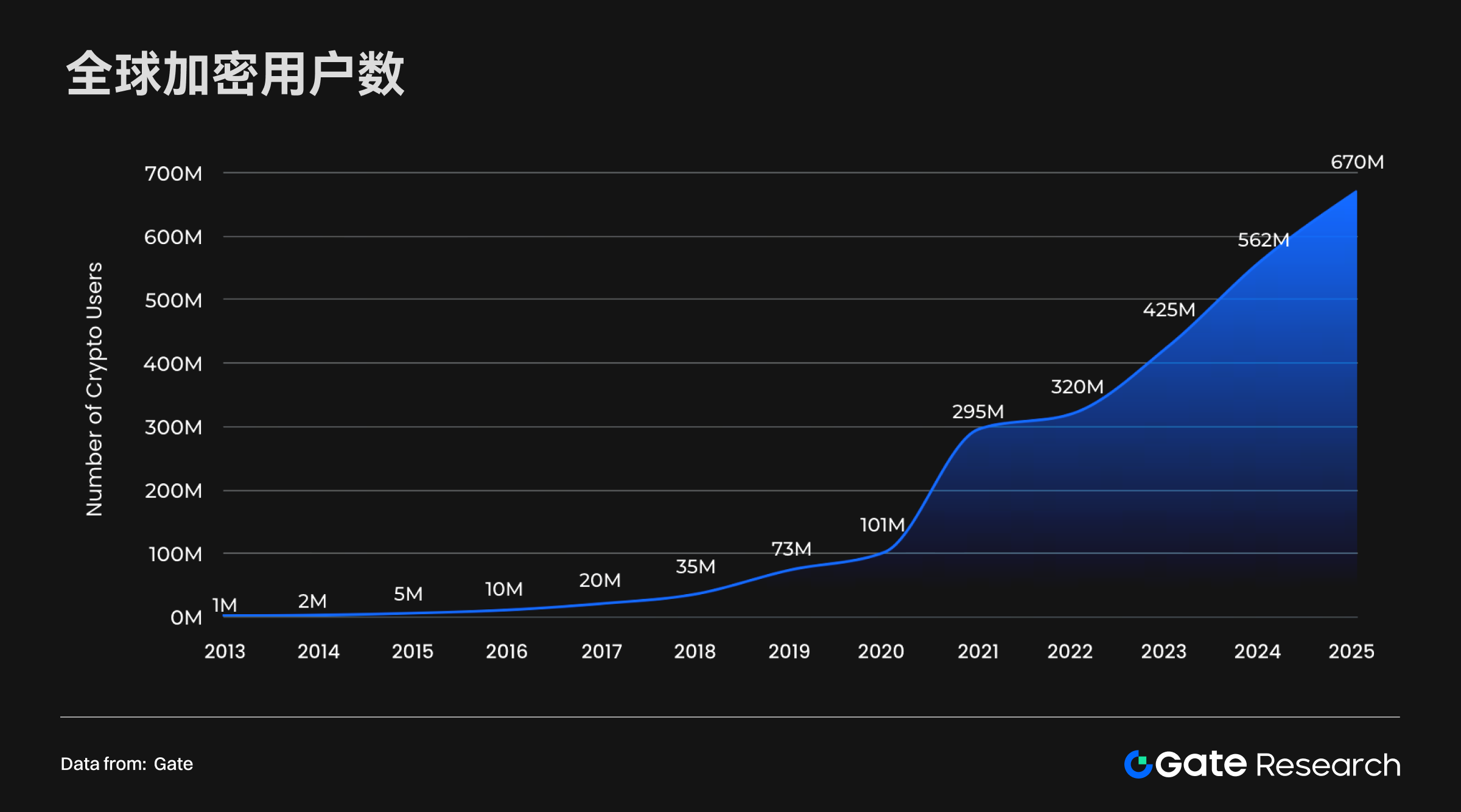
Global Penetration Rate and Regional Distribution: The Rise of Emerging Markets
From a regional distribution perspective, there are significant differences in cryptocurrency user penetration rates:
• High Penetration Markets: South Korea (27%), UAE (25.3%), Singapore (24.4%), Turkey (19.3%), indicating that crypto technology is highly prevalent in these markets. High Penetration Markets
• Emerging Markets: Argentina (18.9%), Thailand (17.6%), Brazil (17.5%), Vietnam (17.4%), Indonesia (13.9%), all have penetration rates above the global average, with cryptocurrencies seen as important tools for financial inclusion.
• Developed Markets: The United States (15.5%), Canada (10.1%) have relatively moderate penetration rates, but still occupy a core position in the global crypto market due to capital, technology, and institutional adoption.
This pattern illustrates that the driving forces behind crypto adoption vary across regions: emerging markets primarily rely on financial alternatives and inclusion needs, while developed markets are more driven by institutional adoption and technological innovation, accelerating the globalization of cryptocurrencies under diverse drivers.
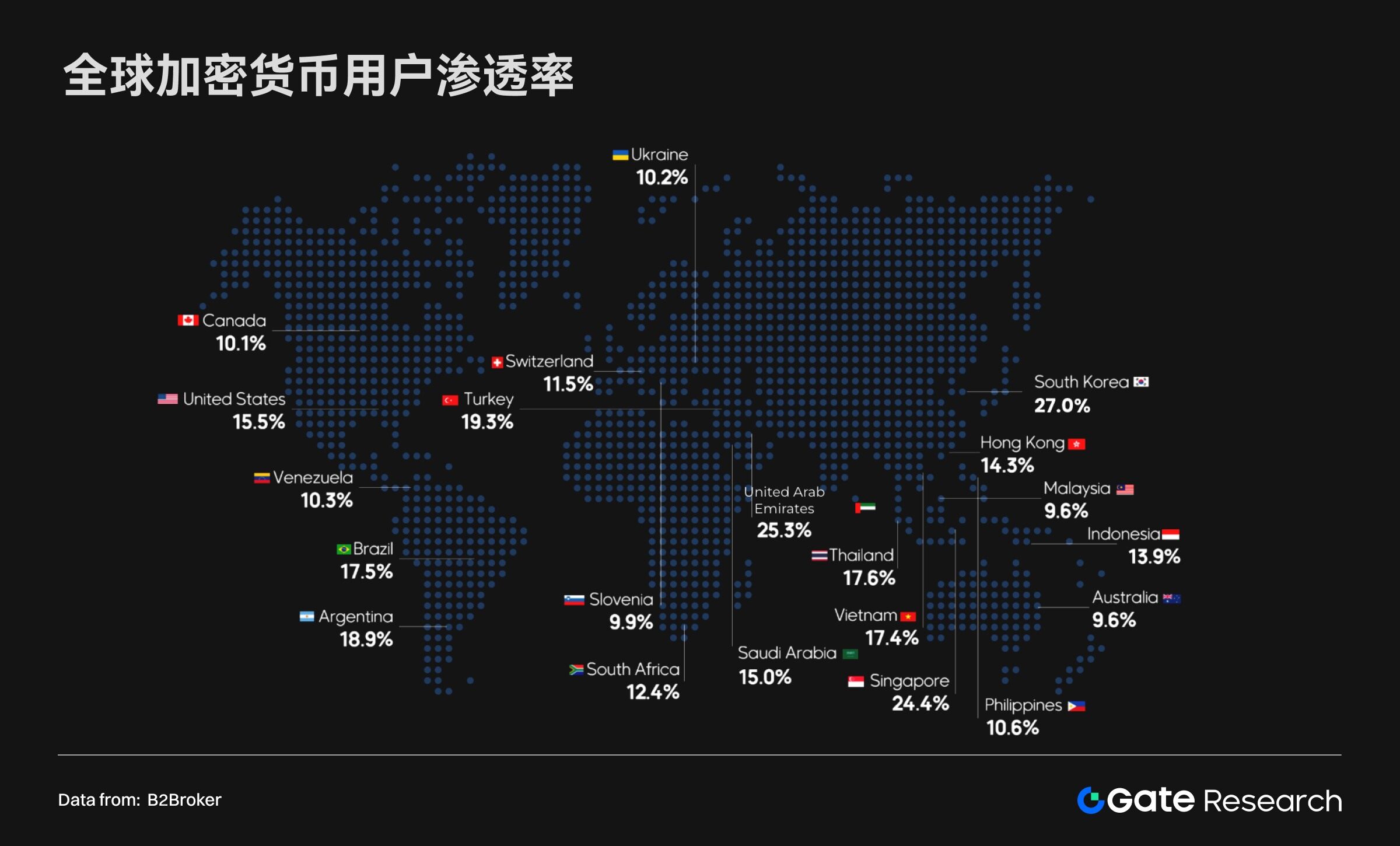
CEX and DEX User Scale Comparison
From 2020 to 2024, both Centralized Exchanges (CEX) and Decentralized Exchanges (DEX) have maintained rapid growth in user scale:
• DEX Users: The number of annual active addresses increased from 9.3 million in 2020 to 143 million in 2024, achieving over 10 times growth in four years, demonstrating strong growth momentum.
• CEX Users: The number of annual active users grew from 22.5 million in 2020 to 120 million in 2024, still showing considerable growth, indicating that centralized platforms continue to hold a key position in the crypto market.
• Trend Evolution: Before 2020, the user scale of CEX was always higher than that of DEX; however, starting in 2021, the user scale of DEX began to surpass CEX, forming a significant gap in 2022. Although the gap narrowed afterward, it expanded again in 2024. As the decentralized ecosystem matures, users are gradually shifting from centralized platforms to the Web 3 ecosystem, but the user bases of both types of platforms are significantly expanding.
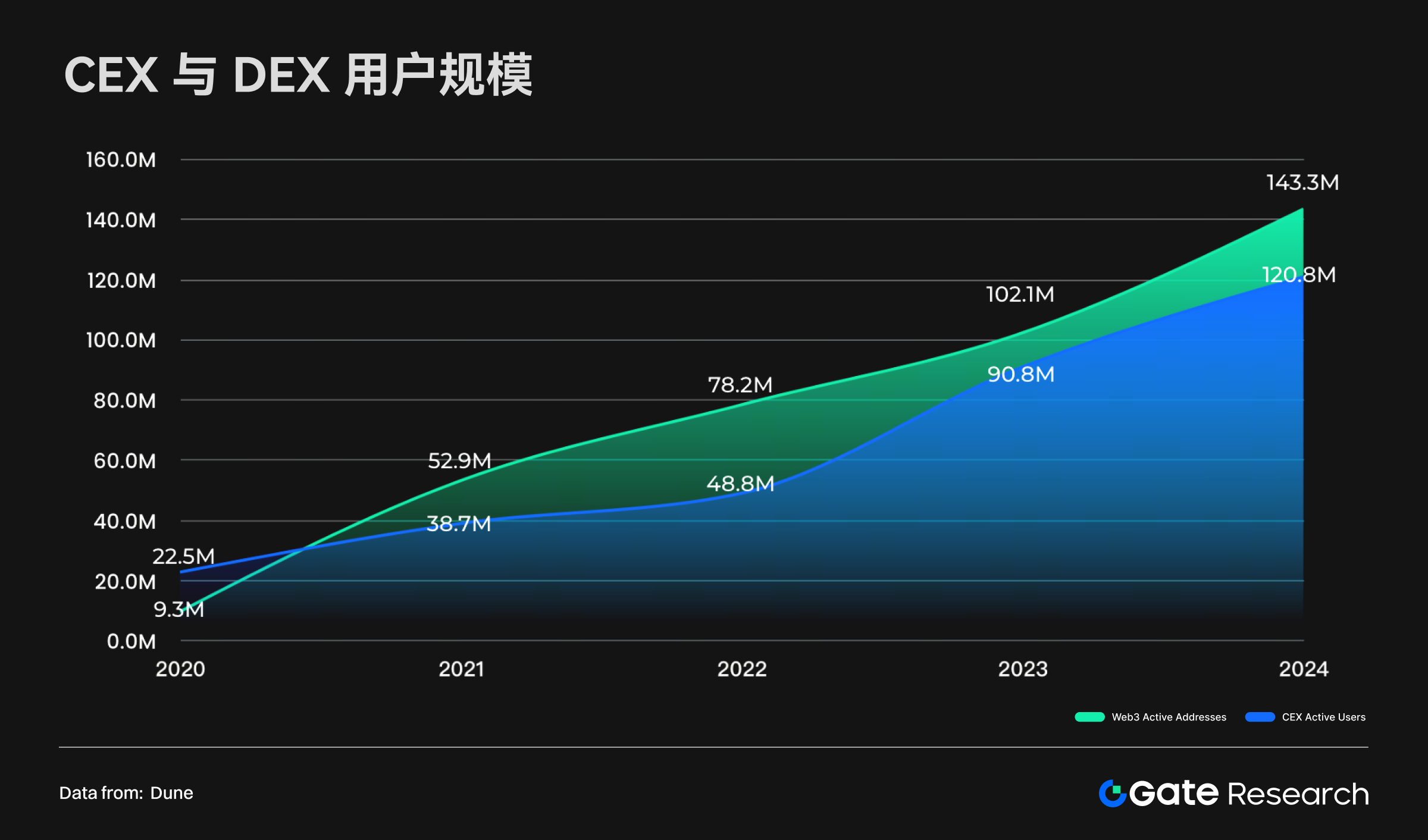
This change reveals:
• User Habits are Shifting — More and more crypto users prefer to use DEX, seeking higher transparency and autonomy;
• Market Structure is Becoming More Diverse — CEX remains the mainstream entry point, but the rise of Web 3 and decentralized applications is reshaping the user structure.
Overall, the user base of the crypto market is expanding from traditional centralized platforms to a decentralized, open Web 3 ecosystem, with market development increasingly showing diverse and decentralized characteristics.
Global Asset Market Value Trends: The Rise of Cryptocurrencies
Cryptocurrencies Moving Towards Global Core Assets (2013–2025)
Between 2013 and 2025, the global asset market value landscape underwent profound reshaping. Traditional hard currencies like gold and silver continued to grow steadily, but their growth rates slowed, and their market shares gradually diluted. Meanwhile, the market capitalization of tech giants expanded rapidly, especially with Microsoft and Nvidia rising sharply after 2020, highlighting that cutting-edge technologies like artificial intelligence and cloud computing are becoming the core engines of global economic growth.
Most notably, cryptocurrencies experienced explosive growth starting in 2020, quickly entering the mainstream of the global asset market. By 2025, their total market value reached $3.02 trillion, successfully surpassing Apple to become the fourth-largest asset class globally, only behind gold, Nvidia, and Microsoft. Among them, Bitcoin (BTC) had a market value of $2.35 trillion, surpassing Amazon and silver; Ethereum (ETH) approached $980 billion; and the total market value of stablecoins also reached $260 billion.
Overall, the core of global assets is gradually shifting from traditional hard assets to high-growth innovative assets. The rise of cryptocurrencies not only demonstrates the immense potential of digital finance but also signifies that they have become a new pillar of global capital allocation alongside gold and tech stocks.
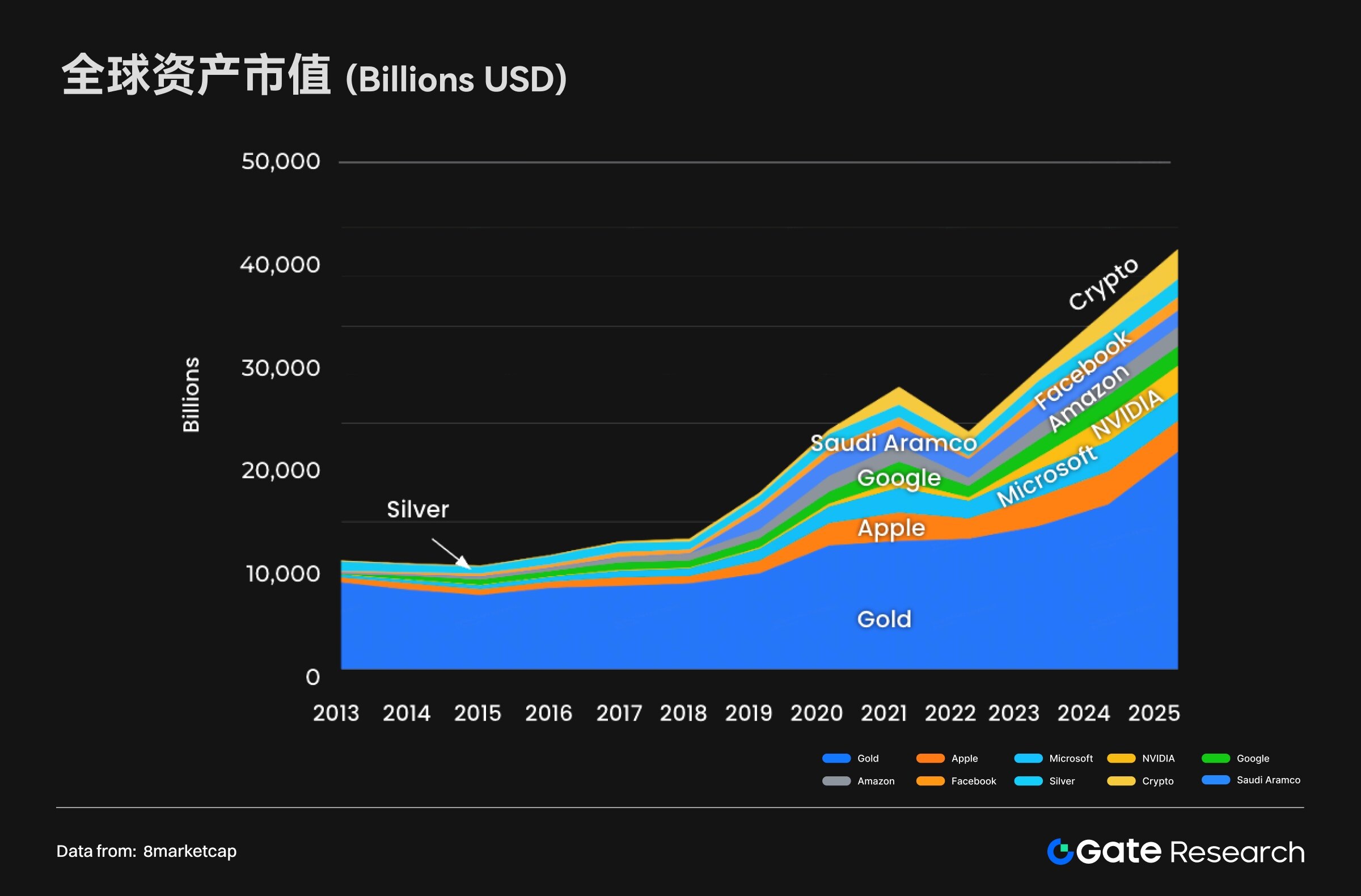
Phased Changes in Global Asset Market Value Structure and Future Trends (2022–2025–2030)
By analyzing market value snapshots at key time points, we can clearly see how cryptocurrencies have grown from marginal assets to core categories that can compete with the world's top tech giants. In August 2022, the global asset landscape was still dominated by traditional assets: gold led with $11.77 trillion, followed by Apple and Microsoft. At that time, the total market value of cryptocurrencies was about $1.08 trillion, already substantial but still in a secondary position comparable to silver ($1.38 trillion).
However, a significant change occurred in just three years. By August 2025, driven by the dual forces of the AI wave and the crypto bull market, the global asset landscape was completely rewritten. The market value of gold rose to $22.93 trillion; Nvidia, leveraging its leading position in AI, saw its market value soar to $4.24 trillion. During this period, cryptocurrencies performed particularly well, with a total market value reaching $3.02 trillion, historically surpassing silver and Amazon, officially entering the core tier of global assets.
In the future, this trend is expected to continue deepening, with forward-looking predictions indicating that by 2030, the total market value of cryptocurrencies could reach $41.80 trillion, becoming the second-largest asset class globally, only behind gold. This exponential rise reflects a massive migration of global capital adapting to the digital age, with the composition of top assets evolving from primarily traditional hard assets to a diversified new structure dominated by traditional assets, tech giants, and digital assets.
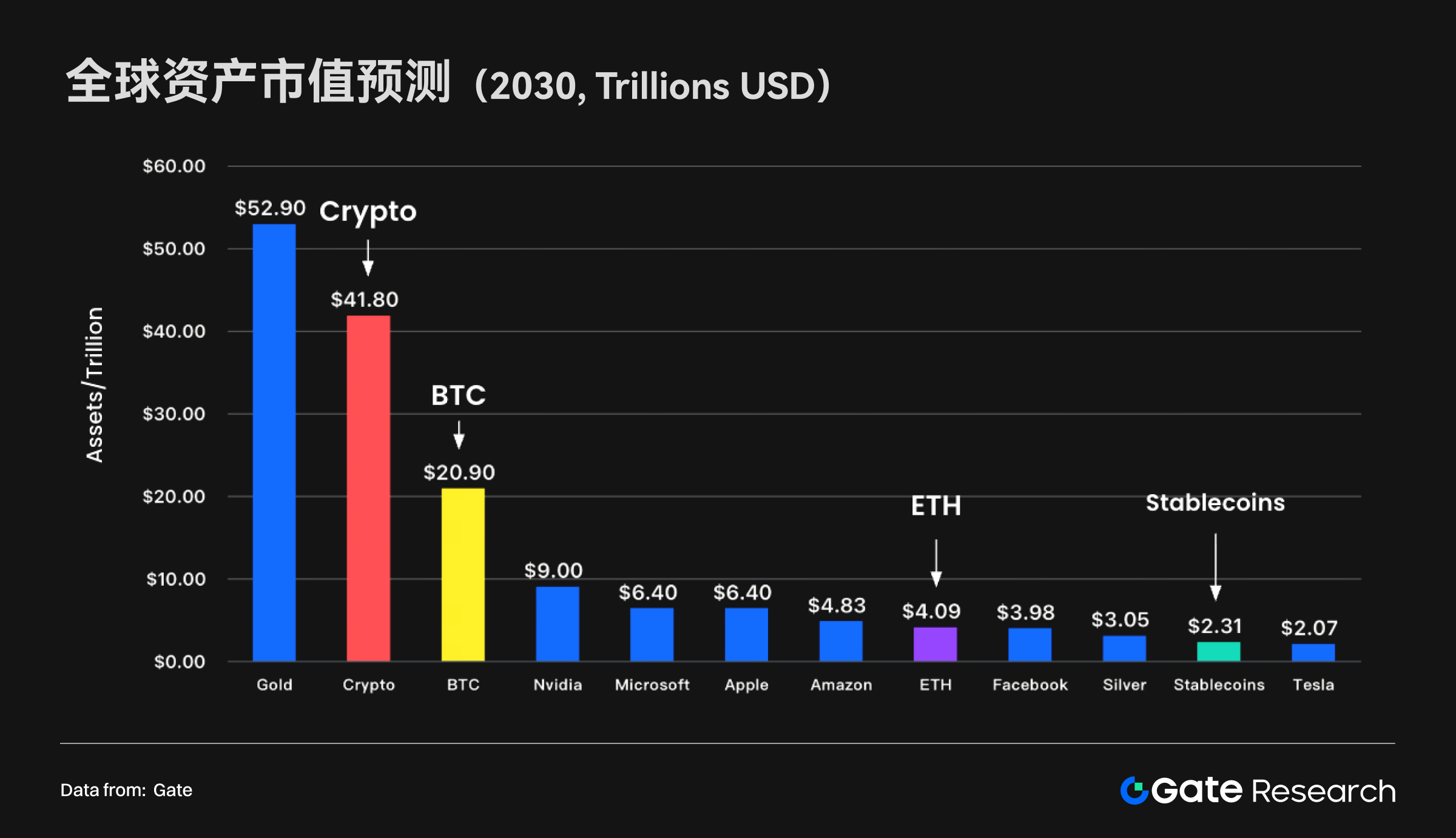
Internal Structural Evolution of the Crypto Market: The Dynamic Balance of CEX and DEX
At the same time, the internal market structure of cryptocurrencies is also maturing and balancing. In the past, asset custody and liquidity relied almost entirely on Centralized Exchanges (CEX); however, by 2025, the landscape has evolved into a "dual-track model" where CEX and Decentralized Exchanges (DEX) run parallel. Data shows that in 2022, the total asset reserves of CEX and DEX were approximately $118 billion, with CEX holding an absolute majority; however, by 2025, the total asset scale surged to $560 billion, with the Total Value Locked (TVL) of DEX significantly increasing, nearly matching the reserves of CEX.
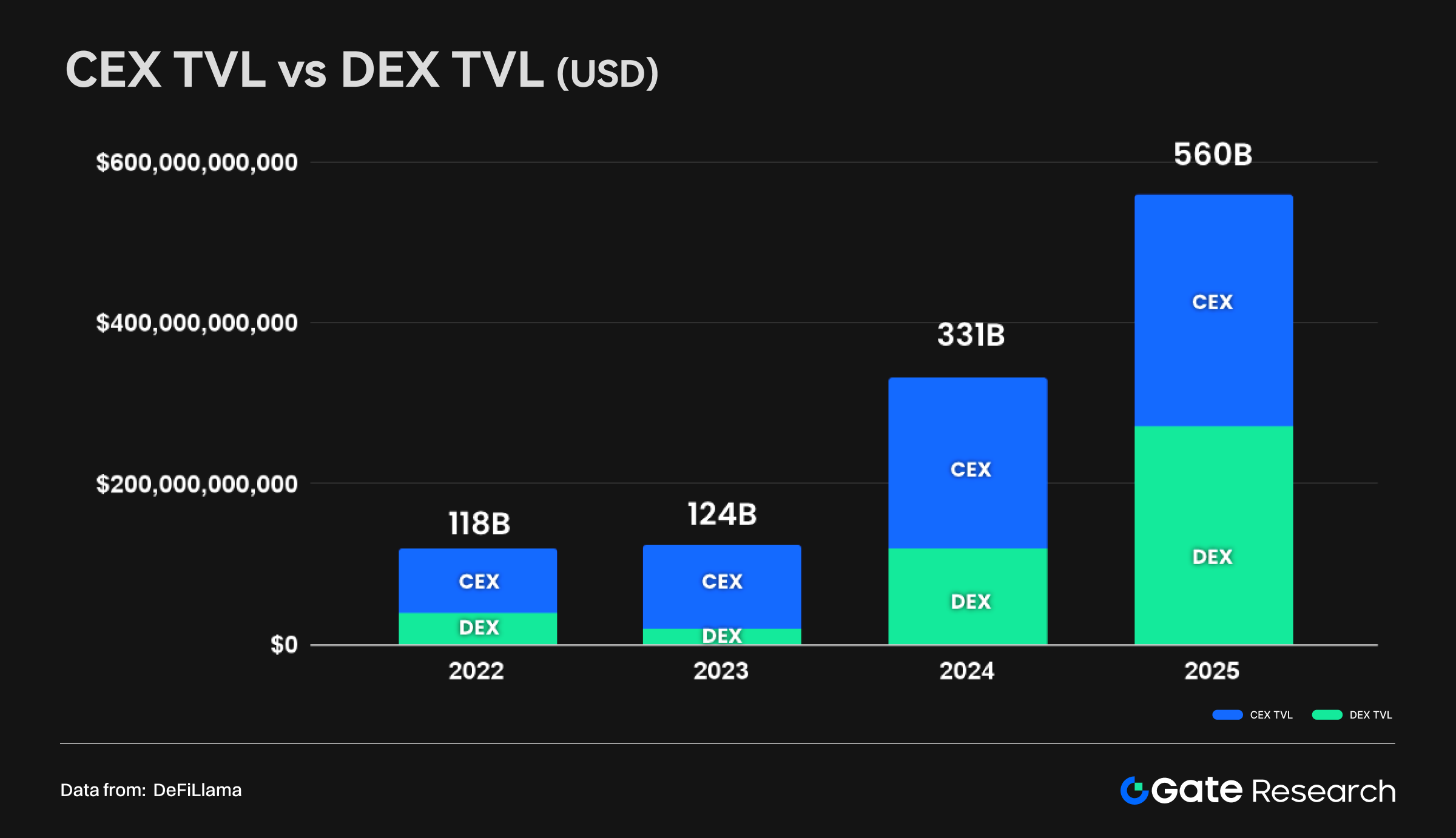
This structural change does not indicate a weakening of CEX's importance but rather signifies the maturation of the crypto market. On one hand, the overall market scale is rapidly expanding, providing ample growth space for both CEX and DEX; on the other hand, the increasing asset share of DEX reflects the prosperity of the DeFi ecosystem, technological advancements, and user preferences for asset self-custody and on-chain transparency. Meanwhile, the role of CEX is also evolving: it is no longer the sole trading center but serves as a "core gateway" connecting the real world with the on-chain economy, undertaking key functions such as fiat currency deposits and withdrawals, new user education, and institutional compliance entry.
Therefore, the crypto market is gradually forming a "dual-track infrastructure" — CEX serves as the entry point and hub for global capital, while DEX acts as the core carrier of on-chain finance and innovation. The two are not in a substitutive relationship but rather complement each other, together forming the dual foundation of the future crypto financial system.
Token Issuance and Ecological Prosperity
The number of token issuances has shown a rapid growth trend in recent years. Especially since the "DeFi Summer" of 2020, decentralized exchanges (DEX) have gradually become the main channel for new token issuances. Today, the volume of token issuances on DEX has reached astonishing levels, with over 50,000 new tokens launched daily. It is estimated that the total number of new tokens in 2025 will exceed 8 million, with cumulative issuance reaching tens of millions. In contrast, while CEX still has a large number of tokens listed, its issuance speed and quantity have clearly lagged behind DEX.
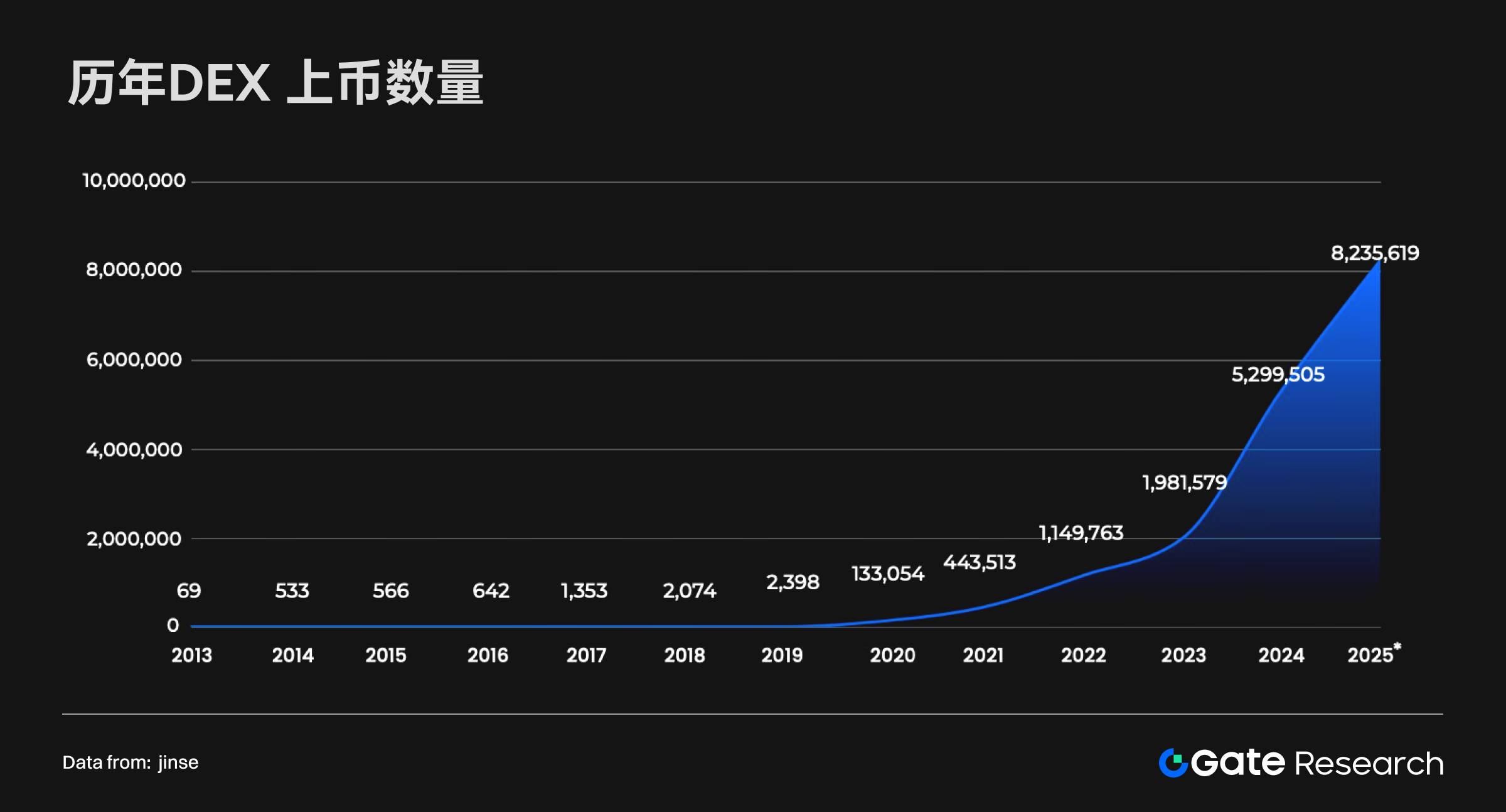
This change in the issuance model has brought about two main effects:
Increased Innovation Prosperity: The openness of DEX provides a broader stage for developers and entrepreneurial teams. New projects can quickly go live and enter circulation, promoting the diversified development and rapid iteration of new sectors such as GameFi, DeFi, and SocialFi.
Risk and Quality Differentiation: Due to the almost non-existent barriers to entry, most tokens on DEX have limited scale and short lifespans, resulting in a market filled with "long-tail projects" that carry high risks. In contrast, CEX still filters projects through strict review mechanisms, leading to fewer issuances but higher token quality and credibility.
In terms of proportion, the vast majority of new tokens are currently issued on DEX, while CEX's share has dropped to less than 1%. This indicates that DEX has taken the initiative in driving the prosperity of the token ecosystem. However, CEX still holds irreplaceable value in terms of "selected projects," brand reputation, and compliance assurance.

In the token issuance scale of various Web 3 Launchpads, over half comes from DEX. This indicates that the prosperity of the ecosystem is shifting from a single model to a dual-track pattern where CEX and DEX coexist.
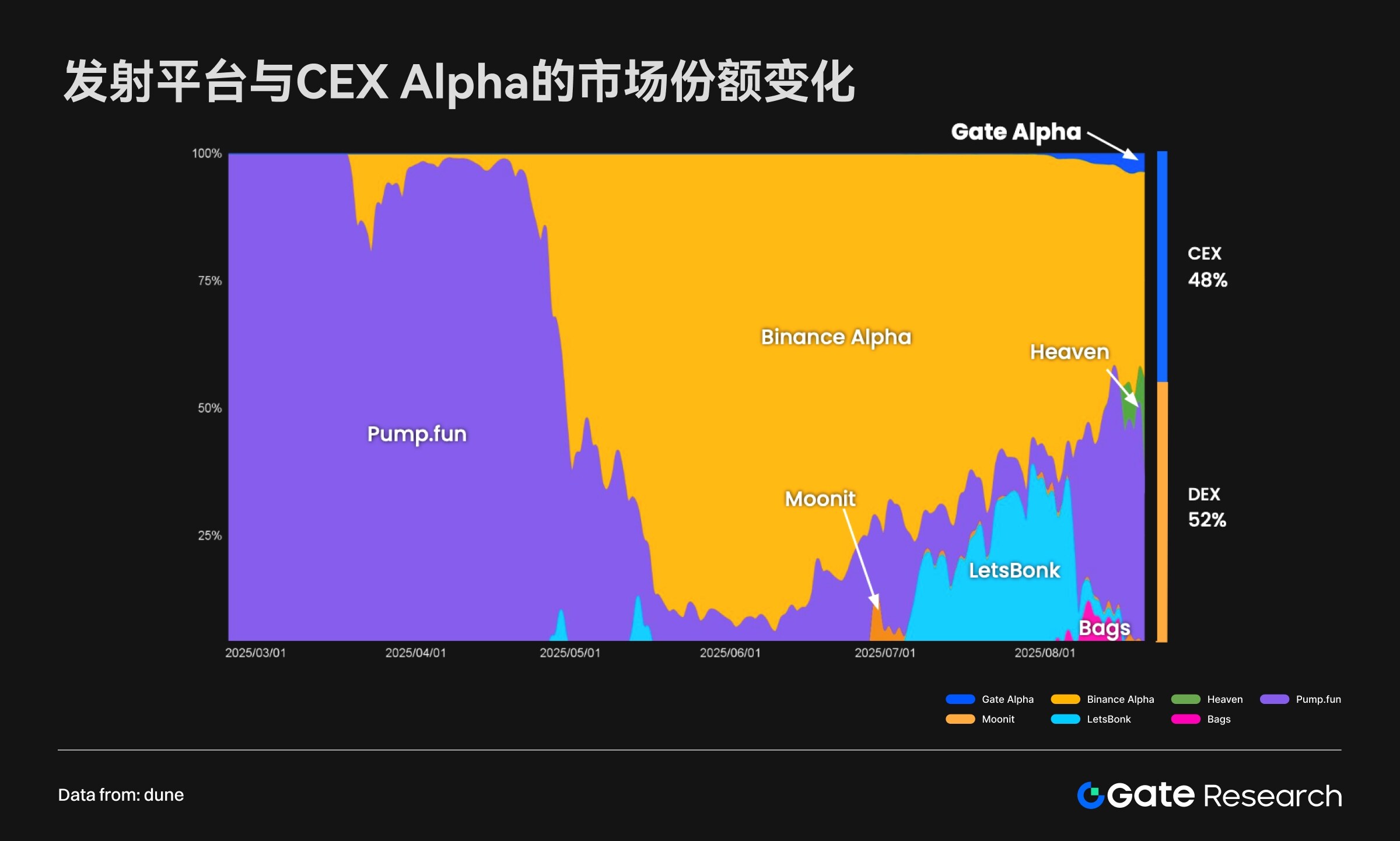
Evolution Trend of Market Dominance
In terms of trading volume and market dominance, the competitive relationship between CEX and DEX is gradually evolving. Overall, CEX remains the core force in the market, but the market share of DEX is continuously increasing, and the gap between the two is gradually narrowing.
Spot Trading
Currently, CEX accounts for about 77% of global spot trading volume, while DEX accounts for 23%. However, if we exclude the impact of wash trading, the data that better reflects real retail activity shows that CEX accounts for 58% and DEX accounts for 42%. This means that in actual user-driven trading, DEX is approaching CEX, demonstrating a rapid catching-up trend.
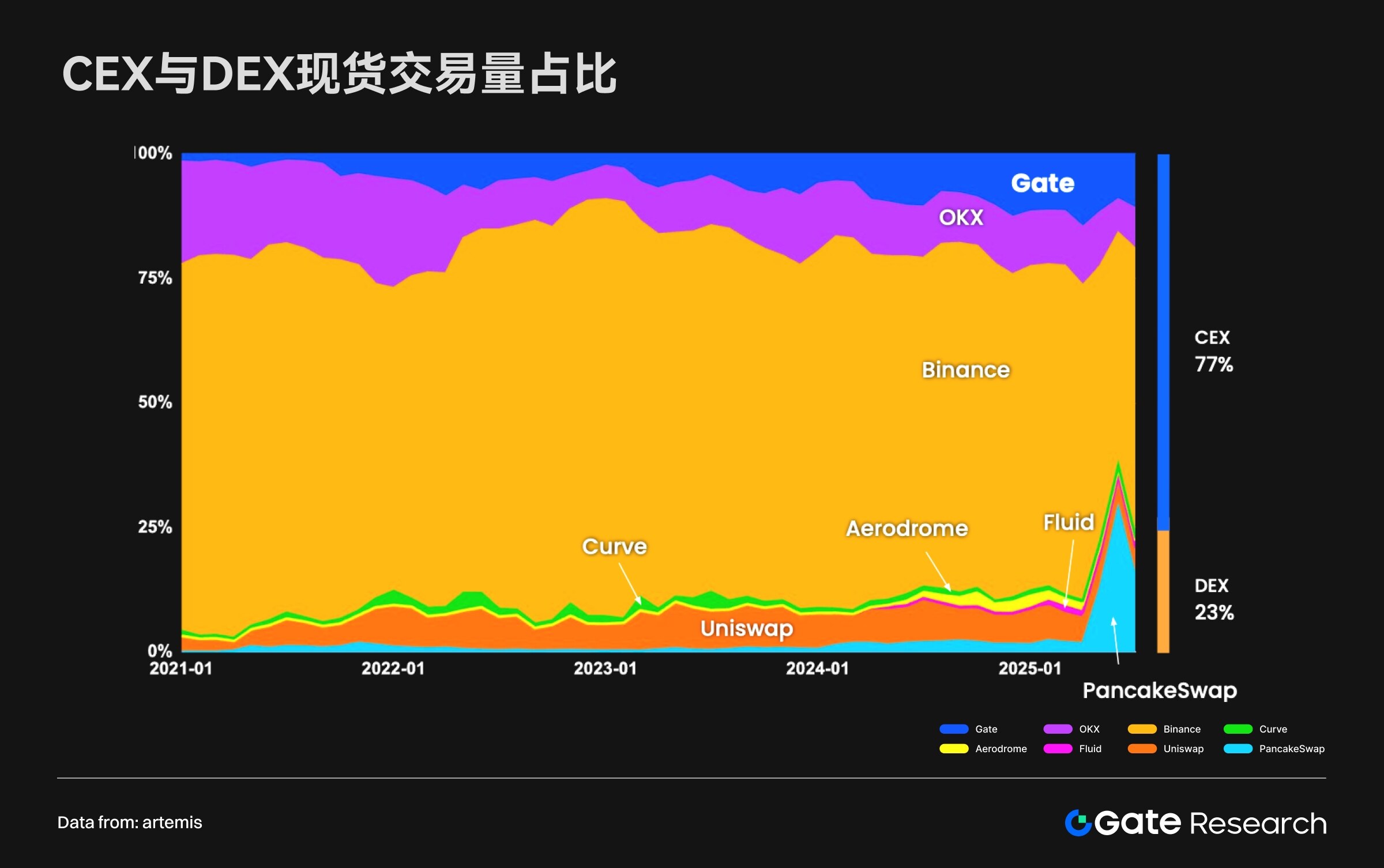

Annual Trading Volume
Over the past decade, the gap in annual trading volume between CEX and DEX has gradually narrowed. Although CEX is still larger in absolute scale, DEX is growing faster and has even approached or surpassed CEX during certain time periods and in emerging asset categories. Meanwhile, in terms of Total Value Locked (TVL) comparison, CEX once held an absolute advantage, but now DEX's TVL has nearly caught up with CEX, forming a balanced dual structure.
Future Trends of Market Dominance
In the short term, CEX will maintain its dominant position due to its deep liquidity, compliance qualifications, and better user experience, especially in regions with strict regulations. In the medium to long term, as blockchain infrastructure continues to improve, user awareness of asset self-management increases, and the security and usability of DEX continue to enhance, its market share is expected to expand further. In the next 5–10 years, DEX may further approach or even challenge the dominance of CEX.
Overall, the market is transitioning from "CEX absolute dominance" to a bipolar pattern of "CEX leading + DEX rapidly catching up." CEX maintains its scale and compliance advantages, while DEX represents the forefront of decentralized ideology and ecological innovation.
Security Risks and Compliance Trends in the Crypto Ecosystem
Hacking Incidents and Financial Losses
Between 2023 and 2025, crypto assets continued to face large-scale thefts. According to Chainalysis data, about 59% of stolen assets came from DEX/Web 3 protocols, with losses amounting to $5.9 billion, highlighting the inadequacies of security mechanisms in decentralized systems. The main types of attacks include smart contract vulnerabilities, cross-chain bridge security failures, and governance design flaws, which expose Web 3 to greater financial security risks. In contrast, while CEX also faces centralization risks, its relatively mature security system results in a lower proportion of financial losses.

At the same time, personal wallet thefts have gradually become a new frontier in crypto crime. As of June 2025, attacks on personal user wallets accounted for over 20% of all stolen funds activities. Due to their covert nature, related incidents are often underreported, but the risk level is continuously rising. The main factors driving this trend include: enhanced security measures on large platforms forcing attackers to target individual users; the expanding population of cryptocurrency holders; the increasing value of personal wallet assets with rising market prices; and hackers using emerging tools like LLM to make attack techniques increasingly complex.

In the context of increasing personal wallet attacks, MetaMask has become one of the most representative cases. Starting from the end of 2024, the number of abnormal fund theft incidents experienced by MetaMask users has significantly increased and continued to rise in 2025. Some attacks resulted in nearly 500 wallets being victimized in a single day, indicating that hackers have developed the capability to systematically target large user groups. In contrast, while there were sporadic peaks in mid-2022 and late 2023, their frequency and severity were far lower than current levels, reflecting an evolution in threat patterns.
Potential reasons for this phenomenon include: vulnerabilities in wallet software that can be systematically exploited, security risks from third-party infrastructures (such as browser plugins or malicious dApps), and a larger target pool formed as the user base expands. Overall, the MetaMask-related cases indicate that widely used wallet applications are becoming prime targets for hackers, and as cryptocurrency applications become more prevalent, such attacks may further spread in the future.

In summary, the current security risks in the crypto ecosystem are characterized by expanding scale and diversified methods, with targets gradually shifting towards individual users. The industry needs to advance security strategies in two areas simultaneously: first, service platforms should continuously strengthen infrastructure protection, including smart contract audits, cross-chain bridge security verification, and multi-signature mechanisms for hot wallets to reduce systemic risks; second, personal user education and protection must also be enhanced, covering operational security (OpSec), cold wallet usage, and prevention against social engineering attacks.
At the same time, regulatory bodies may need to gradually promote compliance requirements for DeFi protocols and wallet applications, seeking a balance between transparency and decentralization to reduce the infiltration of illegal funds through on-chain channels. These risk characteristics also provide important context for subsequent fund flows and money laundering analysis.
Money Laundering and Crypto Fund Flows
Between 2021 and 2024, approximately $50 billion of illegal funds were laundered and defrauded through crypto channels each year, with CEX remaining the primary receiving end for funds. However, with the development of DeFi and no KYC platforms, on-chain protocols have gradually become important outlets for illegal funds, especially during active market phases, where the participation ratio of DeFi has significantly increased. The lack of identity verification and the convenience of cross-chain anonymity make DEX more vulnerable in AML (Anti-Money Laundering) risk management.
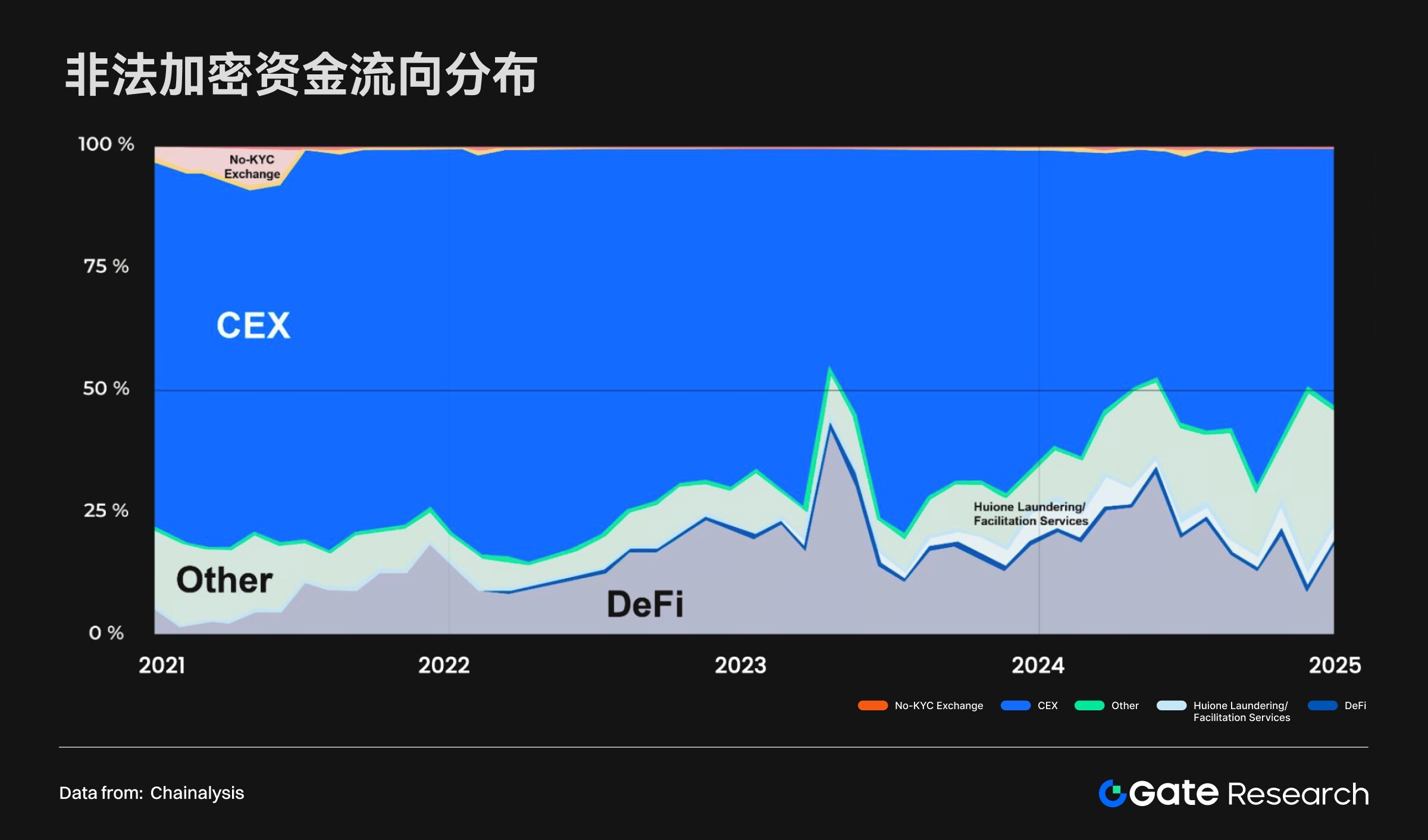
In the period from 2024 to 2025, different types of attacks exhibited differentiated money laundering paths, with attackers on service platforms more frequently using cross-chain bridges and mixers to transfer funds, while stolen funds from personal wallets often flowed into token smart contracts and CEX. Notably, the cost of money laundering has not decreased due to advancements in blockchain technology; rather, it has increased due to the pursuit of speed and irreversibility. From 2022 to June 2025, the average transaction cost on the blockchain decreased by over 80% due to technological advancements in Solana and Layer 2, but the premiums paid by operators of stolen funds increased by over 100%. Additionally, not all funds are immediately circulated; as of June 2025, over 37% of stolen funds from personal wallets remained in the attackers' addresses, showing a hoarding characteristic.
Overall, crypto money laundering is characterized by complex pathways, high premiums for fund transfers, and the stabilization of tools like stablecoins. Although technology has reduced the costs of legitimate transactions, illegal funds have paid higher costs in exchange for efficiency and concealment. This raises higher demands for regulatory and law enforcement efforts in cross-chain tracking, mixer monitoring, and the regulation of sanctioned entities, and it indicates that future compliance pressures on the DeFi and stablecoin ecosystems will further increase. This also highlights the core role of compliance frameworks in industry risk management.
Compliance Responses and Global Layout
In the context of evolving security risks and money laundering pathways, compliance has become a key area distinguishing CEX from DEX. CEX (such as Gate) is gradually establishing compliance frameworks and licensing systems globally to meet the AML/KYC requirements of different jurisdictions. This layout encompasses diverse business forms such as trading, custody, and derivatives, and also means that CEX must fulfill obligations such as information disclosure, customer identity verification (KYC), transaction monitoring, and anti-money laundering reporting. By establishing a global compliance framework, CEX can enhance user trust at the institutional level and lay the foundation for cross-regional business expansion and long-term development.
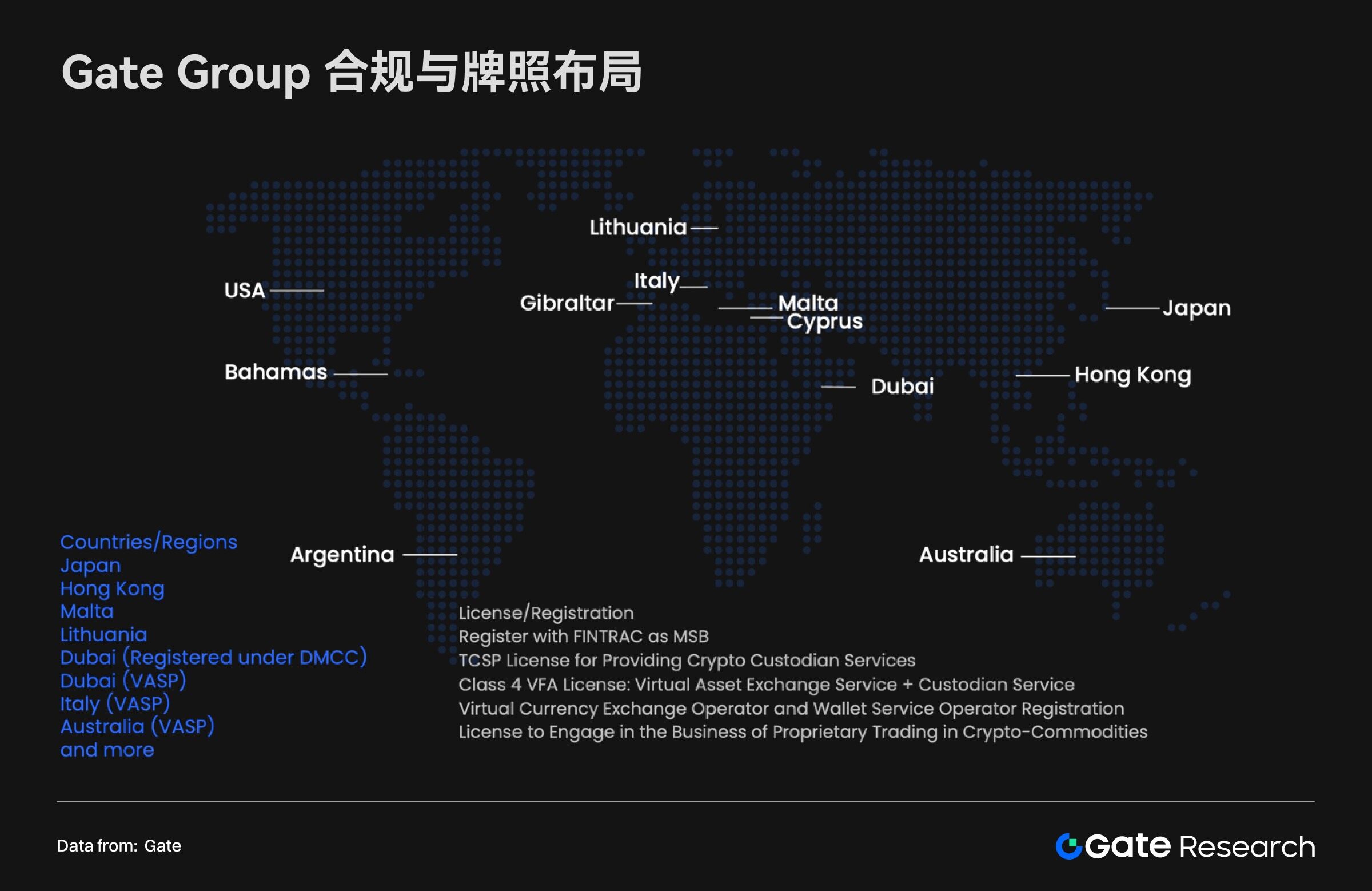
In contrast, the operational model of DEX exhibits significant differences. Due to the lack of centralized legal entities and a unified cross-border regulatory framework, most DEX have not established mandatory compliance mechanisms and typically do not conduct KYC or identity verification. This openness and anonymity provide users with greater freedom but also create a clear gap in AML risk management. Relevant data shows that the proportion of illegal funds circulating on DEX is rising year by year, especially during market volatility phases, making DEX more susceptible to becoming important channels for fraud and hacker funds. Therefore, compliance is not only a systemic benchmark for industry differentiation but will also become an important determining factor in the evolution of future market patterns.
Conclusion
The comparison between CEX and DEX is not only reflected in the differences in trading models but also profoundly mirrors the multi-dimensional evolution of the crypto industry in terms of user growth, market structure, security risks, and compliance frameworks. Over the past decade, the exponential expansion of the user base has propelled the crypto market from a niche experiment to a global mainstream, while the rapid rise of DEX and the steady expansion of CEX have jointly shaped the current diverse and coexisting market landscape.
However, security and compliance remain key variables in the industry's development. Hacking incidents, personal wallet thefts, and the complexity of cross-chain money laundering pathways reveal the vulnerabilities of DeFi and DEX in risk management; meanwhile, CEX provides relatively robust guarantees at the institutional and trust levels through its global compliance layout and more mature security protection systems. This difference also means that the two types of platforms will play different roles in future market competition and regulatory environments.
Looking ahead, CEX and DEX are not in a simple substitutive relationship but are more likely to form a complementary coexistence ecological pattern. CEX's advantages in compliance, liquidity, and user trust will continue to support its position as the mainstream entry point in the market; DEX, on the other hand, will drive the development of token issuance and emerging applications through its openness and innovative capabilities. As the user base continues to expand and regulatory policies gradually improve, finding a balance between transparency, efficiency, and risk control will determine whether the crypto industry can enter a more mature and sustainable stage.
References:
ExplodingTopics, https://explodingtopics.com/blog/cryptocurrency-stats
economictimes, https://economictimes.indiatimes.com/markets/stocks/news/from-uae-to-south-korea-the-worlds-most-crypto-obsessed-countries-in-2025/crypto-watch/slideshow/119897178.cms?utm_source=chatgpt.com\u0026amp;from=mdr
Dune, https://dune.com/queries/3365957/5669035
8 MarketCap, https://8marketcap.com/#google_vignette https://www.physicalgold.com/insights/how-much-silver-is-there-in-the-world/
CoinGecko, https://www.coingecko.com/
Statmuse, https://www.statmuse.com/money/ask/tesla-market-cap-in-august-2022
CompaniesMarketCap, https://companiesmarketcap.com/time-machine/2025-08-01/#google_vignette
ARK, https://www.ark-invest.com/articles/valuation-models/arks-bitcoin-price-target-2030
DefiLlama, https://defillama.com/chains, https://defillama.com/cexs
CoinMarketCap, https://www.jinse.cn/blockchain/3681462.html
Dune, https://dune.com/queries/3830496/6442441?start+date_d83555=2016-12-01+00%3A00%3A00
Dune, https://dune.com/adam_tehc/memecoin-wars, https://dune.com/kucoinventures/cexonchain
Artemis, https://app.artemisanalytics.com/sectors?tab=spotdexs
The Block, https://www.theblock.co/data/crypto-markets/spot/cryptocurrency-exchange-volume-monthlys
CoinMarketCap, https://coinmarketcap.com/; DEX: https://defillama.com/dexs
Slowmist, https://hacked.slowmist.io/
Chainalysis, https://hacked.slowmist.io/ https://www.chainalysis.com/wp-content/uploads/2025/03/the-2025-crypto-crime-report-release.pdf
Chainalysis, https://www.chainalysis.com/wp-content/uploads/2025/03/the-2025-crypto-crime-report-release.pdf
Gate Research Institute is a comprehensive blockchain and cryptocurrency research platform that provides readers with in-depth content, including technical analysis, hot insights, market reviews, industry research, trend forecasts, and macroeconomic policy analysis.
Disclaimer
Investing in the cryptocurrency market involves high risks. Users are advised to conduct independent research and fully understand the nature of the assets and products they purchase before making any investment decisions. Gate is not responsible for any losses or damages resulting from such investment decisions.
免责声明:本文章仅代表作者个人观点,不代表本平台的立场和观点。本文章仅供信息分享,不构成对任何人的任何投资建议。用户与作者之间的任何争议,与本平台无关。如网页中刊载的文章或图片涉及侵权,请提供相关的权利证明和身份证明发送邮件到support@aicoin.com,本平台相关工作人员将会进行核查。




